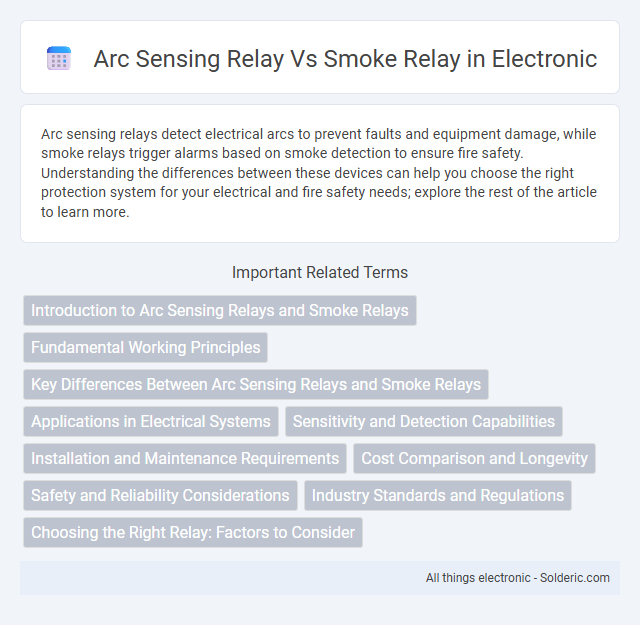Arc sensing relays detect electrical arcs to prevent faults and equipment damage, while smoke relays trigger alarms based on smoke detection to ensure fire safety. Understanding the differences between these devices can help you choose the right protection system for your electrical and fire safety needs; explore the rest of the article to learn more.
Comparison Table
| Feature | Arc Sensing Relay | Smoke Relay |
|---|---|---|
| Purpose | Detects electrical arc faults in circuits | Detects presence of smoke indicating fire |
| Detection Method | Monitors electrical noise and arcing patterns | Uses optical or ionization sensors to detect smoke |
| Typical Applications | Industrial electrical panels, circuit protection | Residential and commercial fire alarm systems |
| Response Action | Triggers circuit interruption to prevent fire | Activates alarms and fire suppression systems |
| Sensitivity | Focuses on arc fault current signatures | Detects varying smoke particle densities |
| Installation Location | Within electrical distribution boards | Ceilings, walls, or HVAC ducts |
| Standards Compliance | UL 1699 (Arc-Fault Circuit Interrupters) | UL 217 (Smoke Alarms) |
Introduction to Arc Sensing Relays and Smoke Relays
Arc sensing relays detect electrical arcs by monitoring current and voltage irregularities to prevent potential fire hazards caused by electrical faults. Smoke relays respond to the presence of smoke particles, triggering alarms to signal early stages of fire. Both devices enhance fire safety but focus on distinct detection methods: electrical fault arcs versus airborne smoke.
Fundamental Working Principles
Arc sensing relays detect electrical arcs by monitoring high-frequency current signals caused by unintended electrical discharges, enabling rapid identification of faults in electrical systems. Smoke relays operate by sensing particulate matter using optical or ionization methods to detect smoke presence and trigger alarms in fire detection systems. Understanding these fundamental working principles helps you choose the appropriate relay type for reliable fault detection or fire safety monitoring.
Key Differences Between Arc Sensing Relays and Smoke Relays
Arc sensing relays detect electrical arcs by monitoring high-frequency current changes, providing fast response to prevent fire hazards in electrical systems. Smoke relays activate based on smoke particle detection through optical or ionization sensors, primarily targeting early fire detection in airspaces. The key difference lies in arc sensing relays' focus on electrical fault detection versus smoke relays' emphasis on atmospheric fire detection.
Applications in Electrical Systems
Arc sensing relays are primarily used in electrical systems to detect and isolate arc faults, preventing potential fire hazards and equipment damage in industrial and commercial settings. Smoke relays are installed in fire detection systems to sense smoke particles, triggering alarms and activating fire suppression mechanisms for early fire warning in residential and commercial buildings. Your choice between these relays depends on the specific safety requirements of electrical arc fault detection or smoke detection in your facility.
Sensitivity and Detection Capabilities
Arc sensing relays offer higher sensitivity by detecting electrical faults through precise monitoring of arc signatures and transient current disturbances, enabling rapid identification of arcing faults in electrical systems. Smoke relays rely on particulate detection in the air, primarily using ionization or photoelectric sensors, which limits their sensitivity to smoke concentration and delays detection until combustion or smoldering occurs. Therefore, arc sensing relays provide superior early fault detection capabilities in electrical environments, whereas smoke relays are more suited for fire detection in general occupancy zones.
Installation and Maintenance Requirements
Arc sensing relays typically require specialized installation involving precise sensor placement to detect electrical arcs accurately, often necessitating trained technicians for setup and calibration. Smoke relays have simpler installation processes, generally mounted within HVAC or fire alarm systems, with straightforward wiring and routine battery or sensor replacements. Maintenance for arc sensing relays focuses on sensor cleanliness and calibration checks, whereas smoke relays demand regular testing and sensor replacements to ensure smoke detection reliability.
Cost Comparison and Longevity
Arc sensing relays generally have a higher initial cost compared to smoke relays due to their advanced technology and enhanced detection accuracy. Smoke relays tend to be more affordable upfront but may require more frequent maintenance and replacement because of their shorter lifespan. Your choice should consider that arc sensing relays often offer greater longevity and reduced long-term operational costs despite the higher upfront investment.
Safety and Reliability Considerations
Arc sensing relays provide enhanced safety by quickly detecting fault currents caused by electrical arcing, preventing fire hazards more reliably than smoke relays, which respond only after smoke is present. Their rapid response capabilities reduce the risk of electrical fires, improving overall system reliability and protection. Your electrical safety depends on choosing arc sensing relays for early fault detection rather than relying solely on smoke relays for post-incident alerts.
Industry Standards and Regulations
Arc sensing relays and smoke relays adhere to stringent industry standards and regulations such as UL 508 for industrial control equipment and UL 268 for smoke detectors, ensuring reliable performance and safety compliance. Arc sensing relays comply with IEEE and NFPA 70E guidelines focused on electrical fault detection, while smoke relays meet NFPA 72 fire alarm and detection system standards for early fire warning. Your facility's safety system must align with these regulations to guarantee optimal protection and regulatory approval.
Choosing the Right Relay: Factors to Consider
Choosing the right relay depends on the specific safety requirements of your environment. Arc sensing relays detect electrical faults by monitoring high-frequency signals caused by arcing, making them ideal for preventing electrical fires in complex wiring systems. Smoke relays trigger alarms based on particulate detection, offering crucial early warnings of fire hazards where smoke presence is a primary risk.
arc sensing relay vs smoke relay Infographic

 solderic.com
solderic.com